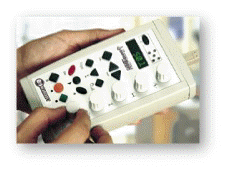|
| |
||||||
The Focus EMG Machine has arrived
| GUIDES & INFORMATION | ||
|
|
Electronic EMG Manual® | |
|
|
Peripheral Nerves Anatomy | |
|
|
General Muscles Anatomy | |
|
|
Nerve Conduction Set-Ups | |
|
|
Needle EMG Anatomy Atlas | |
|
|
Patient Education Series (FAQ) | |
|
|
Nerve Entrapment Guide | |
|
 |
||||||||||||||||||||||||||||
|
EMG Normal Values are at http://www.mynorms.com |
|||||||||||||||||||||||||||||
|
Your doctor has just ordered a test called an EMG. EMG stands for Electromyogram which loosely translated means electrical testing of muscles but in fact has come to mean electrical testing of nerves and muscles. The EMG is performed by a specialist, the Electromyographer, who is usually a Neurologist or a Physiatrist. Parts of the test (the nerve conductions) may be performed by a specially trained technician. It is an in-office procedure and does not require hospitalization. On average, an EMG takes anywhere between 30 minutes and 2 hours, depending on how extensive a testing your doctor orders on you. It can be done at any time during the day and, with few exceptions, does not require any special preparation. Sometimes EMGs are thought to be a treatment of some sort, or a type of acupuncture. This is not true; an EMG is only a test, much like an EKG or an X-ray are tests and not treatments. What are some problems for which EMGs are
ordered? What happens during an EMG? The second part of the test is called Needle Examination and as the name implies, involves some needle sticking. The needles used are thin, fine and about one and a quarter inches long. This part tests the muscle to see if there has been any damage to it as a result of the nerve problem or if the disease involves the muscle itself rather than the nerve. Usually 5 to 6 muscles are sampled in one extremity, but occasionally, if you have problems in more than one area, additional muscles may need to be studied. The needle is usually inserted in the relaxed muscle and moved inside gently in order to record the muscle activity. When this is done, you will be able to hear the sound of the muscle activity amplified by the EMG machine; it will sound something like radio static. The painful part of this section is when the needle is first inserted through the skin since all of the pain receptors are located in this area. Once inside the muscle, the sensation is usually perceived as discomfort or pressure rather than pain. During the needle exam, no electrical shocks are delivered. Also, since the needle probe is used here only as a recording device, no injections are given through the needle into the muscle. On the average, a muscle can be sampled in 2 to 5 minutes though this may vary with the type of problem being investigated. How long does an EMG take? What kind of preparations are necessary
for an EMG? With few exceptions, you may continue taking medication prescribed by your physician as ordered without this interfering with the EMG. However, if you are taking a blood thinner, you should notify the Lab where your EMG is being done, since in that case the needle part of the test may cause bleeding inside the muscle. Also if you are on any medication for Myasthenia Gravis such as Mestinon or other, your medication may interfere with the test, so you should also notify the Lab. If you have any doubts about other medications you are taking, it is best to check with the Lab to be on the safe side. Can I ask for some pain medication? How soon will I find out the results? How much will an EMG cost? Most insurance policies cover EMGs, though
frequently the coverage is not 100% and the primary care or insurance
physician will have to OK it before it can be ordered. It is best
to have your doctor’s office find out what kind of coverage
you have for an EMG. |
|||||||||||||||||||||||||||||
|
This page was last updated on
Sunday, March 04, 2012
|
|
© Copyright 1997-2012
TeleEMG, LLC. All rights reserved
- TeleEMG is a Massachusetts Limited Liability Company (LLC)
|


